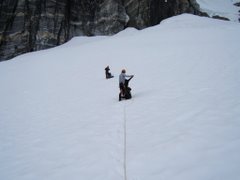 Canada Glacier
Canada Glacier Pond behind Andrew's ridge south of Lake Hoare
Pond behind Andrew's ridge south of Lake Hoare Canada Glacier ( left) and Mount Erebus (distant right)
Canada Glacier ( left) and Mount Erebus (distant right)Today Sandra (camp assistant) and I sampled the lower western part of the Canada Glacier, the lower the easier to find melt. Sediment blown onto the glacier is heated by the circling sun, melting into the glacier's surface. Channels meander or race down the glacier wherever the sediment is blown and collects. In this way, the sediments make their way back down off the glacier back to the wind-belted bed it came from. The lighter, more mobile dust particles are blown further up the glacier high into the zone where snow accumulates and beyond. Dust from major glaciations (when Columbus, Ohio was covered by ice) blew into the oceans fertilizing them, providing valuable nutrition.
What role do the dust and sediment play for the life existing in these extreme conditions?



1 comment:
Hi Sarah,
I am in CHC, just had dinner and am wiped out, but I wanted to check your blog to see what you are up to. I hope that beautiful weather holds and I can't wait to do some sampling. I don't know when I will acutually get into the field but we are supposed to fly to MCM on Thursday.
Post a Comment